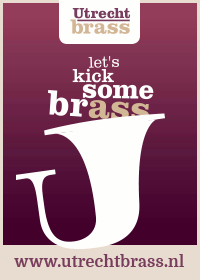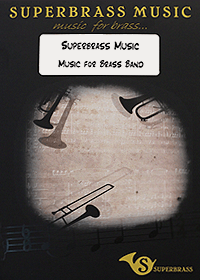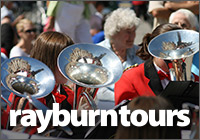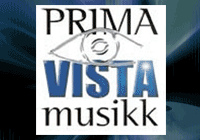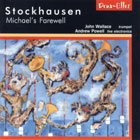 Stockhausen – Michael’s Farewell
Stockhausen – Michael’s Farewell
22-Nov-2002
John Wallace and Andrew Powell – trumpet and live electronics
Deux–Elles Recordings: CD DXL 1039
Total Playing Time: 57 mins
There is no easy way to describe this CD. It is very very very very odd. That being said though it is also one of the most beguiling CD's you will ever listen to.
John Wallace is a world renowned trumpet soloist who has explored the outer reaches of trumpet repertoire for close on a quarter of a century. We have been privileged to review two releases from him on 4BR that have featured some cutting edge contemporary repertoire as well as one release that has seen him delve into the rich ancestral heritage of the instrument.
"The Golden Section" and "Hammered Brass" saw Wallace explore the margins of current brass writing for ensemble, whilst "Baltic Brass" (released also by Deux-Elles) saw his famous Wallace Collection exhume repertoire from the late 19th century composers Sibelius and Ewald. Each were superb showcases for the players talents and gave the listener an enriching musical experience. However, where these may safely be described as "on the margin", "Stockhausen Michael's Farewell" has skipped two pages and the flyleaf and quite possibly is in a different musical bookshop all together.
The four pieces bring together Wallace and Andrew Powell, a Surrey born composer and musician of Welsh parentage who has worked with such groups as Mike Fleetwood of Fleetwood Mac, Chris de Burgh and Kate Bush as well as writing scores for films featuring Michelle Pfeiffer and Burt Lancaster. He has also written for brass, with his "Falstaff" premiered by Grimethorpe Colliery Band in Paris in 1998 and works for the Wallace Collection and James Watson.
The amalgam of live trumpet and "live" electronics is therefore a combination that at first wouldn't seem to have a lot going for it, but when approached with a clear mind becomes strangely affecting. All four pieces are different in thought and execution and whilst it would be fair to say they are not pieces you could whistle a tune to, they are nevertheless very accessible. The release was also featured recently in the "Observer" newspaper in their CD reviews (something not a single brass band release has done for many a year) and was well received by them.
"Plasmogeny II" features Wallace combined with live electronics and tape and is a sister piece to an initial work, by Powell himself written as far back as 1970. Plasmogeny itself means "the development of an organism from plasma" and as such gives you the initial germ of the idea behind the piece. The work is in three sections with the soloist through the electronics being able to have his sound and phrases altered in numerous forms, including the ability for the player to perform in four part harmony with himself.
The first section is almost primordial as Wallace explore the range of the instrument an octave below it's fundamental notes, whilst the second has echoes of a Miles Davis lyricism. The third is fast and furious and features exchanges between "Kodo" drums on tape and Wallace playing at the extremities over harmonic dubbed lines. It is strangely arresting. Difficult at first yet with the ability to draw the listener further and further into the music so at it's end you feel satisfaction without really knowing quite why.
"Echo III" was written by composer Roger Smalley in July 1978 and as the title suggests develops initial musical thoughts through repetition. In this case Wallace plays a "theme" which is then repeated at intervals of 5 seconds from your left loudspeaker and 10 seconds from your right. It therefore gives rise to a three part canon, which develops and overlaps gradually and almost imperceptibly.
Differing ideas are then explored in the same manner so that the effect becomes almost hypnotic. At a central point the music then unfurls like a flag back towards a point when the ideas become less and less intertwined and more separate so that the initial idea becomes distinct once more. The soloist then delves into two final sections of the work that feature "toneless" blowing a concept that is very effective as the work draws to a close. Again you are left a little bewildered but strangely satisfied with what you have heard.
"The Transistor Radio of St. Narcissus" meanwhile is a huge solo work almost 25 minutes in length that was written by the composer Tim Souster for Wallace in 1983. Tim Souster's work for brass has been recorded before notably by Doyen Recordings (DOYCD073 with The Wallace Collection and Desford Colliery Band) and his works are accessible yet challenging to the ear.
The title comes from a passage in the book "The Crying of Lot 49" by Thomas Pynchon where a woman is reminded how the angular aerial layout of a modern Californian housing complex looks like a circuit board from a transistor radio. (Think of the famous night time aerial picture of down town Los Angeles in the film "Close Encounter's of a Third Kind"). The music relates this by mirroring pitch and time and the way the focus of the music changes through a journey of the sound spectrum.
Wallace performs on a flugel horn which starts at the highest reaches of the instrument and gradually works down and down into the middle pitch and finally the lowest stratas. The electronics meanwhile manipulate these strands, modulating in numerous guises before we finally reach a base point where the fundamental Bb tone of the instrument is achieved. It is a very difficult work to listen to, yet once more you are drawn into it. Many of the electronic effects remind you strangely of the soundtrack to the first "Terminator" film featuring Arnie "I'll be Back" Scwarzenegger. Odd stuff but then Arnie was always a little hard to take wasn't he?
Finally, , the title track itself "Michaels Abscheid" by Karlheinz Stockhausen, written in 1980 and first performed by five trumpets at La Scala in Milan in 1981, where the players performed it from 2 roof terraces and 3 balconies around the famous square.
The idea is formal each player plays a musical pattern, which varies in length between 12 and 36 seconds with pre arranged pauses in between each rendition. The payers also stop playing at intervals of around one and a half minutes so once more the music intertwines and develops almost canonically. Wallace plays all the parts on this occasion with the recording of each part over dubbed so that the effect becomes almost chilling as each motif has its own echo. Again the effect is stimulating for what seems a reason that you cannot quite explain to yourself.
This CD has been perhaps the most challenging release we have had to review on 4BR. We are great fans of John Wallace and contemporary brass music in general yet this left us slightly bewildered. That is not to say we didn't like it far from it, yet we didn't really know why we did.
Take the opportunity to find out for yourselves though. It will leave you scratching your head for sure, but with a wry smile of satisfaction on your face when you are doing it
What's on this CD?
1. Plasmogeny II, Andrew Powell, 9.46
2. Echo III, Roger Smalley, 10.48
3. The Transistor Radio of St. Narcissus, Tim Souster, 24.08
4. Michaels—Abschied, Karlheinz Stockhausen, 12.47
Total Play Time: 57 mins




